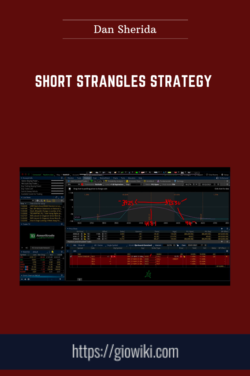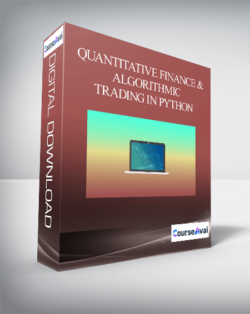Salepage link: At HERE. Archive: https://archive.is/B3O96Total sizes: 216 MB – include: Buy now $72 $212, Mean Reversion Strategies In Python – Dr. Ernest P. Chan-Quantinsti Course.Offered by Dr. Ernest P Chan, this course will teach you to identify trading opportunities based on Mean Reversion theory. You will create different mean reversion strategies such as Index Arbitrage, Long-short portfolio using market data and advanced statistical concepts. A must-do course for quant traders.APPLY MEAN REVERSION STRATEGIESCreate four different types of mean reverting strategiesPerform statistical test for identifying stationarity and co-integrationBacktest pairs trading, triplets, index arbitrage and long-short strategyExplain the role of risk managementPaper trade and live trade your strategies without any installations or downloadsIntroduction to the CourseThis section gives an overview of the mean reversion strategy through examples. You will go through the course structure and understand how the course is structured in videos, quizzes, strategy codes and interactive coding exercises. This will make sure that not only do you understand the mechanics of mean reversion but also implement trading strategies in live markets.Introduction by Dr. Ernest ChanIntroduction to Mean Reversion StrategyCourse Structure Flow DiagramQuantra Features and GuidanceTypes of Statistical Arbitrage StrategiesStationarity of Time SeriesStationary is one of the essential concepts upon which pairs trading and other cointegrated trading is built. This section discusses the concept of stationary through real price data and how it is different from the random walk.What is Stationarity?Mean Reversion Trading ApproachTemporary Mean ReversionStationarityStatistical Test for StationarityAugmented Dickey-Fuller TestThis section covers the concept of the augmented dickey-fuller (ADF) test, which is used to check whether the price series is stationary or not. You will learn the mathematics behind the ADF test. You will also learn to check the stationarity of currency pairs in Python.Pre Reading MaterialsWhat is ADF Test?Purpose of ADF TestADF Test AssumptionNull HypothesisStationary Price SeriesMath Behind ADF Test (Optional)Critical Value and Test StatisticsHow to Use Jupyter Notebook?ADF Test on CADUSD PairCalculate Test StatisticsImport Library and Read CSVAdditional ReadingFrequently Asked QuestionsMean Reversion StrategyIn this section, you will learn to create and backtest a trading strategy based on the concept of mean reversion. You will learn to use the Bollinger Bands to create a mean reversion strategy on a currency pair.Mean Reversion StrategyUpper BandTrading Based on Mean ReversionMean Reversion Strategy on AUDCADCalculate Moving Average and Standard DeviationUpper and Lower BandLong Entry and ExitShort Entry and ExitLong and Short PositionsForward Fill Missing PositionsConsolidate the PositionsCompute PnLRecapFrequently Asked QuestionsTest on Mean ReversionLive Trading on BlueshiftThis section will walk you through the steps involved in taking your trading strategy live. You will learn about backtesting and live trading platform, Blueshift. You will learn about code structure, various functions used to create a strategy and finally, paper or live trade on Blueshift.Section OverviewLive Trading OverviewVectorised vs Event DrivenProcess in Live TradingReal-Time Data SourceBlueshift Code StructureImportant API MethodsSchedule Strategy LogicFetch Historical DataPlace OrdersBacktest and Live Trade on BlueshiftAdditional ReadingBlueshift Data FAQsLive Trading TemplateIn this section, a live trading strategy template will be provided to you. The template strategy will be on the mean reversion strategy covered in the previous section. You can tweak the code by changing different currency pairs, date range to backtest and finally analyse the strategy performance in more detail.Paper/Live Trading FX Mean Reversion StrategyFAQs for Live Trading on BlueshiftCointegrationFree PreviewIf a linear combination of two or more price series is stationary, then the individual price series are said to be cointegrated with each other. This section introduces cointegration between two-time series and covers a test for detecting cointegration of a portfolio of instruments called the cointegrated augmented Dickey-Fuller (CADF) test.What is Cointegration?CointegrationCorrelationWhat is Hedge Ratio?Portfolio Formation Using Hedge RatioHedge Ratio CodeImport LibraryCalculate Hedge RatioWhat is CADF Test?Check Cointegration using CADF TestOrder Dependence of CADFPairs TradingMost financial instruments are not stationary, and creating a mean reversion strategy is not possible on such a price series. To overcome this issue, you need two price series which are cointegrated with each other. In this section, you will learn to create a pairs trading strategy using the Bollinger Bands. You will also learn to backtest the same in Python.Mean Reversion Strategy on PairsMean Reversion Strategy on GLD-GDXTake Long Entry and ExitCompute Strategy PnLPaper/Live Trading Pair Trading StrategyAdditional ReadingRecapMean Reversion StrategyTripletsThis section discusses failure of the mean reversion strategy of the GLD-GDX pair. Based on the possible reason we will arrive at the conclusion of choosing a triplet to improve the mean reversion strategy. The working of Johansen test will be explained to arrive at the hedge ratios for the new mean reversion strategy for triplets. This section also covers the concept of half-life of mean reversion along with Ornstein-Uhlenbeck formula for computing the half-life of mean reversion.Cointegration Breakdown in the GLD-GDX PairReason of Breakdown of CointegrationSignificance of CointegrationSurviving Breakdown of CointegrationHow to Survive Breakdown of Cointegration?Breakdown RemediesOptimization ProblemsEigenvalues and EigenvectorsWhat is Johansen Test?CADF ShortcomingsLinear CombinationGLD-GDX Cointegration TestMean Reversion on TripletsMean Reversion on Triplets CodeGLD-GDX-USO Cointegration TestCointegration TestTaking PositionsRecapFrequently Asked QuestionsHalf LifeThis section explains how long would it it take for the time series to revert back to the mean. And the importance of half-life to select the right instruments to trade in.Half Life of Mean Reverting Time SeriesHalf LifeHalf Life FormulaHalf-Life Using Johansen TestCompute Half-Life of GLD-GDXFrequently Asked QuestionsRisk ManagementThis section explains the importance and two common usages of stop loss in mean reverting strategies. Further, you will learn to backtest mean-reverting strategy with and without stop and compare the performance of the strategy.Stop-LossMean Reversion Strategy With Stop LossBest Markets to Pair TradeThis section explains the pros and cons of mean reversion strategies in different markets such as exchange traded funds (ETFs), stocks, currencies, and futures. Further, in the section, will understand how economically related pairs do not co-integrate, cover the basic concept of crack spread and test for stationarity of crack spread.Best Markets To Pair TradeMean Reversion of ETF PairsMean Reversion of Stock PairsMean Reversion of Currencies and FuturesCointegration Test of CL and BZCointegration Test of Crack SpreadIdentify Cointegrated Stock PairsIndex ArbitrageThis section explains Index Arbitrage Strategy which is an extension of pairs and triplets, how to construct a basket of instruments and see the difficulties of trading an Index Arbitrage strategy.Index Arbitrage StrategyWorking of Index Arbitrage StrategyCustom BasketIndex Arbitrage Strategy CodeDifficulties in Index ArbitrageLong Short PortfolioThis section explains the concept of long-short portfolio strategy, how it is different from other mean reversion strategies. Further, will construct a long-short portfolio of stocks in the S&P 500, understand the importance of universe selection of stocks on strategy and learn to refine a strategy.Long-Short portfolio StrategyLong-Short PortfolioStrategy FormulaLong-Short Portfolio Strategy CodeCalculate Stock ReturnsCalculate Market ReturnsCalculate Dollar Allocation for Each StockCalculate Sharpe RatioPaper/Live Trading Long-Short StrategyAnalysis of Strategy PerformanceTest on Trading Based on Mean ReversionRun Codes Locally on Your MachineLearn to install the Python environment in your local machine.Python Installation OverviewFlow DiagramInstall Anaconda on WindowsInstall Anaconda on MacKnow your Current EnvironmentTroubleshooting Anaconda Installation ProblemsCreating a Python EnvironmentChanging EnvironmentsQuantra EnvironmentTroubleshooting Tips For Setting Up EnvironmentHow to Run Files in Downloadable Section?Troubleshooting For Running Files in Downloadable SectionAutomated Trading Using IBridgePyA live trading strategy template will be provided to you. You can tweak the template to deploy your strategies on Interactive Brokers using IBridgePy API.Additional ReadingSample Strategy to Run on Interactive BrokersSummaryCourse SummaryPython Codes and DataTag: Mean Reversion Strategies In Python – Dr. Ernest P. Chan-Quantinsti Download, Mean Reversion Strategies In Python – Dr. Ernest P. Chan-Quantinsti review, Mean Reversion Strategies In Python – Dr. Ernest P. Chan-Quantinsti Discount, mean reversion strategies, short term mean reversion strategies, mean reversion strategies trading, best mean reversion strategies, mean reversion strategies in python

 Short Strangles Strategy – Dan Sheridan
₹11,454.00
Short Strangles Strategy – Dan Sheridan
₹11,454.00
 Tr3ndy Jons Supply Demand System – Simpler Trading –
JONATHAN MCKEEVER
₹21,414.00
Tr3ndy Jons Supply Demand System – Simpler Trading –
JONATHAN MCKEEVER
₹21,414.00
Mean Reversion Strategies In Python – Dr. Ernest P. Chan-Quantinsti
₹11,952.00





